Bay Bolete
(Imleria badia)
Conservation • Description • Habitat • Ecology • Distribution • Taxonomy
|
|
||||||||||||||
Description |
Bay Bolete is a common and widespread, easily recognized, medium-sized, mushroom. It occurs in Europe and North America. In the United States, it occurs from Maine to New Jersey, west to Minnesota, and south along the Appalachian Mountains to North Carolina. It also occurs in the Pacific Northwest. There are several widely scattered sightings elsewhere, almost all of them east of the Great Plains. It is uncommon in Minnesota, where it reaches the western extent of its range. Bay Bolete is found in summer and fall in coniferous and mixed forests, mostly under pine, also under spruce and hemlock, and occasionally under hardwoods, especially beech, oak, and chestnut. It grows on the ground, alone, scattered, or in groups but not clustered (gregarious), on soil and on well-rotted logs and stumps. It is often hidden under pine needles or ferns. It obtains its nutrients from the rootlets of trees and provides neutral or positive feedback (ectomycorrhizal). When it first appears, the cap is convex and the surface is sticky. The mature cap is broadly convex and 13⁄16″ to 3½″ (3 to 9 cm) in diameter. It can be brown, pinkish brown, or often reddish brown, the color of a bay horse. This is the feature that gives the mushroom both its common name and its species epithet. The surface is dry, leathery, and without hairs or scales (bald). The margin has a narrow, flattened, 1⁄32″ to 1⁄16″ (1 to 2 mm) wide sterile portion. The pore surface is dull pale yellow at first, becoming yellow as it ages, and brownish yellow at maturity. When bruised or cut it turns blue or grayish blue. The pores are medium sized and angular, with 2 to 3 pores per 1⁄32″ (1 mm). The pore tubes are up to ⅜″ (1 cm) deep. The stalk is solid, tough, 2″ to 7″ (5 to 18 cm) long, and ⅝″ to 19⁄16″ (1.5 to 4 cm) thick. It may be equal in width from top to bottom or tapered to a wider base, and it is often slightly curved at the base. There is no ring. It is white or pale yellow and more or less heavily streaked with reddish-brown. The surface is longitudinally wrinkled, and it is covered with cottony threads (fibrilose). The flesh is mostly white, but it is pale yellow just above the tubes. It remains unchanged or turns light blue when cut. It is edible. The spore print is olive brown. |
Similar Species |
Habitat and Hosts |
Coniferous and mixed forests |
Ecology |
Season |
Summer and fall |
Distribution |
||
|
Sources |
|
| 10/26/2024 | ||
Occurrence |
||
Common in the east, uncommon in Minnesota |
||
Taxonomy |
|
Kingdom |
Fungi (Fungi) |
Subkingdom |
Dikarya |
Phylum |
Basidiomycota (Basidiomycete Fungi) |
Subphylum |
Agaricomycotina (Higher Basidiomycetes) |
Class |
Agaricomycetes (Mushrooms, Bracket Fungi, Puffballs, and Allies) |
Subclass |
Agaricomycetidae |
Order |
Boletales (boletes and allies) |
Suborder |
Boletineae |
Family |
|
Subfamily |
Boletoideae |
Genus |
Imleria |
|
|
This species was originally described as Boletus castaneus ß badius, a subspecies, in 1818. It was later renamed as a variety. In 1931 it was moved to the genus Xerocomus, but this genus was not widely accepted. In 2014, based on a morphological analysis and three genetic analyses, the genus Imleria was erected to contain this one species. |
|
Subordinate Taxa |
|
|
|
Synonyms |
|
Boletus badius Boletus castaneus var. badius Boletus glutinosus Boletus limatulus Boletus messanensis Boletus paludosus Boletus stejskalii Boletus vaccinus Dictyopus aereus var. vaccinus Ixocomus badius Rostkovites badia Rostkovites badus Suillus badius Suillus limatulus Suillus vaccinus Tubiporus vaccinus Viscipellis badia Xerocomus badius |
|
Common Names |
|
Bay Bolete |
|
Glossary
Ectomycorrhizal
A symbiotic, neutral, or beneficial relationship between a fungus and the tiny rootlets of a plant, usually a tree, where the hyphae surround but do not penetrate the rootlets.
Fibrillose
On mushrooms, covered with fine hair-like fibers.
Visitor Photos |
||
Share your photo of this fungus. |
||
This button not working for you? |
||
Paul |
||
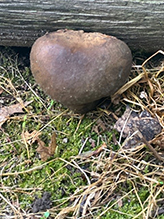 |
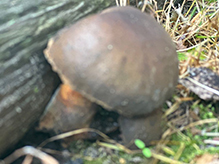 |
|
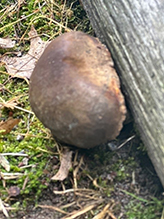 |
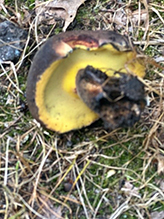 |
|
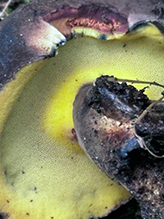 |
|
|
MinnesotaSeasons.com Photos |
||
|
||
|
||

Slideshows |
|

Visitor Videos |
||
Share your video of this fungus. |
||
This button not working for you? |
||
|
Other Videos |
||
Identifying the Bay Bolete, Imleria badia |
About
Nov 21, 2023 This is a great late Autumn edible |
Identifying edible mushrooms - Bay bolete, aka Imleria badia. |
About
Sep 18, 2020 Learn the identification features of one of our common edible fungi. |

Visitor Sightings |
||
Report a sighting of this fungus. |
||
This button not working for you? |
||
|
|
MinnesotaSeasons.com Sightings |
||
|

|
Created: 10/26/2024 Last Updated: © MinnesotaSeasons.com. All rights reserved. |
